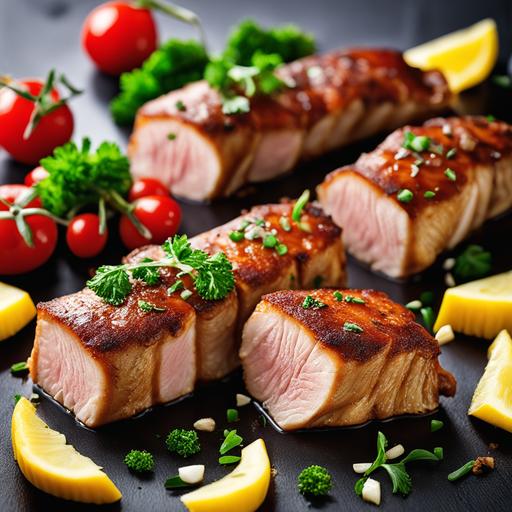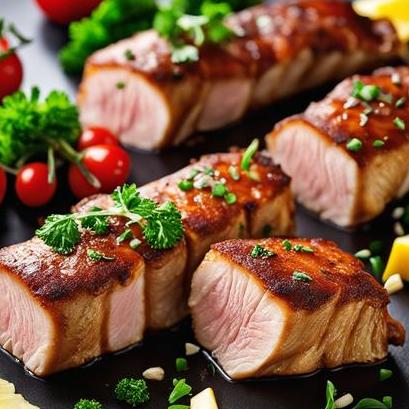
The Ultimate Guide To Tenderloins Oven Recipe
When it comes to preparing a mouth-watering, juicy, and perfectly cooked tenderloin in the oven, there are a few key factors to consider. In this comprehensive guide, we will dive into the world of tenderloin cooking, covering everything from the food science behind this delectable cut of meat to culinary techniques, tips, recipe variations, and even doneness checks. So grab your apron, sharpen your knives, and let’s get cooking!
Understanding Tenderloins: A Meat Lover’s Delight
Tenderloin, also known as filet mignon, is an incredibly tender cut of meat that comes from the loin area of the animal. It’s highly regarded for its tenderness, buttery texture, and mild flavor. Tenderloin is a popular choice for special occasions and fine dining experiences, making it an excellent choice for anyone looking to impress their guests or create a memorable meal.
Selecting the Perfect Tenderloin
Choosing the right cut of tenderloin is crucial to ensure a successful cooking experience. Here are a few tips to help you select the perfect piece:
-
Look for Quality: Opt for tenderloin cuts that have marbling, which is the thin streaks of fat running through the meat. This contributes to its tenderness and adds flavor during cooking.
-
Size Matters: Go for a tenderloin that is at least 1.5 inches thick. Thinner cuts tend to dry out quickly during cooking.
-
Color Check: Choose a tenderloin with a deep red color, as this indicates freshness.
Cleaning and Preparing the Tenderloin

Before diving into the cooking process, it’s essential to properly clean and prepare the tenderloin. Set aside some time to follow these steps:
-
Trimming: Begin by trimming any excess fat or silver skin from the tenderloin. Removing these will enhance both the taste and texture of the final dish.
-
Seasoning: Generously season the tenderloin with salt, pepper, and any desired herbs or spices. Allow the flavors to penetrate the meat by refrigerating it for at least 2 hours, or overnight if possible. This step ensures a well-seasoned and flavorful piece of meat.
Culinary Techniques and Cooking Tips

Now that your tenderloin is prepped and ready, it’s time to focus on the cooking process. The oven method is a popular choice for its ability to cook the meat evenly and retain its juices. Here are some culinary techniques and tips to help you achieve perfection:
-
Preheating: Begin by preheating the oven to 425°F (220°C). This high heat will create a beautiful crust on the outside of the tenderloin while keeping the inside tender and juicy.
-
Searing: Heat a cast-iron skillet or oven-safe pan over high heat. Sear the tenderloin on all sides until it develops a golden-brown crust. This step adds depth of flavor and enhances the overall presentation.
-
Roasting: Transfer the seared tenderloin to a preheated oven. Roast it until it reaches the desired doneness. Remember to base your cooking time on the weight and thickness of the cut. A general guideline is 10-12 minutes for medium-rare, 13-15 minutes for medium, and 16-20 minutes for well-done.
-
Resting: Once the tenderloin is cooked to perfection, remove it from the oven and let it rest for about 5-10 minutes. This allows the juices to redistribute, resulting in a more tender and flavorsome meat.
Checking the Doneness

Determining the doneness of a tenderloin is crucial to ensure it’s cooked to your desired level. Here are some signs to help you gauge the internal temperature:
-
Thermometer: Invest in a meat thermometer to accurately measure the internal temperature. For medium-rare, look for a temperature of around 135°F (57°C). Medium will range around 145°F (63°C), and well-done will be approximately 160°F (71°C).
-
Finger Test: If you don’t have a thermometer, use the finger test technique. Gently press the meat with your finger – a relaxed feel indicates rare, slightly firm indicates medium, and firm indicates well-done.
Recipe: Classic Oven Roasted Tenderloin

Ingredients:
-
2 pounds (900g) of beef tenderloin, trimmed
-
2 tablespoons of olive oil
-
Salt and pepper to taste
-
3-4 sprigs of fresh rosemary
Instructions:
-
Preheat the oven to 425°F (220°C).
-
Season the tenderloin generously with salt and pepper, ensuring all sides are coated.
-
Heat a cast-iron skillet or oven-safe pan over high heat.
-
Add olive oil to the pan and sear the tenderloin on all sides until browned (approximately 2 minutes per side).
-
Add the rosemary sprigs to the pan, and transfer the pan to the preheated oven.
-
Roast the tenderloin for approximately 10-12 minutes for medium-rare, adjusting the time accordingly for your desired level of doneness.
-
Once cooked to perfection, remove the tenderloin from the oven and let it rest for 5-10 minutes.
-
Slice the tenderloin into thick, juicy medallions, and serve with your favorite sides.
Variations to Elevate Your Tenderloin Experience
While the classic oven roasted tenderloin is undoubtedly delicious, there are numerous variations you can explore to enhance the flavors and create a more personalized dish. Here are a few ideas to inspire your culinary creativity:
-
Blue Cheese Crust: Combine blue cheese, breadcrumbs, butter, and minced garlic. Spread this mixture on top of the tenderloin before roasting to create a delectable crust.
-
Bacon-Wrapped: Wrap the seasoned tenderloin with bacon strips. The bacon fat will render and infuse the meat with an irresistible smoky flavor during roasting.
-
Red Wine Reduction: Create a rich and flavorful sauce by deglazing the pan with red wine after searing the tenderloin. Reduce the wine until it thickens, and serve it alongside the perfectly cooked meat.
The Finishing Touches
To fully enjoy your tenderloin masterpiece, consider plating it with care and complementing flavors. Here are some finishing touches to elevate your dish:
-
Garnishes: Sprinkle fresh herbs such as thyme or chives over the sliced tenderloin for a pop of color and added freshness.
-
Sauce Pairings: Accompany your tenderloin with a favorite sauce such as béarnaise, mushroom, or peppercorn to enhance the flavors further. These sauces beautifully balance the richness of the meat.
-
Side Dish Selection: Opt for sides that complement the tenderloin’s flavor and texture. Consider roasted vegetables, creamy mashed potatoes, or a light salad for a well-rounded meal.
Enjoy the Culinary Journey
Cooking a perfect tenderloin in the oven is truly a culinary journey worth embarking on. Armed with your new understanding of the meat, culinary techniques, and an array of delicious variations, you are now ready to impress your family and friends with your expertise. Embrace this guide as a starting point and let your creativity soar. Happy cooking!
FAQS On Tenderloins Oven Recipe
What Temperature Should I Preheat The Oven To When Cooking Tenderloins?
It is recommended to preheat the oven to 425°F (220°C) for cooking tenderloins. This high temperature ensures that the meat cooks evenly and develops a delicious crust on the outside while remaining tender and juicy on the inside.
How Long Should I Cook Tenderloins In The Oven?
The cooking time for tenderloins depends on the weight and thickness of the meat. As a general guideline, a 1-pound (450g) tenderloin should be cooked for approximately 20-25 minutes. However, it is essential to use a meat thermometer to ensure that the internal temperature reaches 145°F (63°C) for medium-rare, 160°F (71°C) for medium, or 170°F (77°C) for well-done.
Should I Marinate The Tenderloins Before Baking Them In The Oven?
While not necessary, marinating tenderloins before baking can enhance their flavor and tenderness. A simple marinade can be made by combining olive oil, minced garlic, soy sauce, Worcestershire sauce, dried herbs, and salt and pepper. Place the tenderloins in a resealable bag, pour in the marinade, and refrigerate for at least 1 hour or overnight before cooking.
Can I Sear The Tenderloins Before Baking Them In The Oven?
Searing the tenderloins before baking is optional but highly recommended. This extra step helps to create a beautiful caramelized crust on the meat’s surface, enhancing both appearance and flavor. To sear, heat a tablespoon of oil in a skillet over medium-high heat, and cook the tenderloins for 2-3 minutes on each side until they develop a golden-brown crust. Then transfer them to a preheated oven to finish cooking.
How Can I Ensure The Tenderloins Remain Juicy And Tender During Baking?
To keep the tenderloins moist and tender while baking, you can baste them with melted butter or a mixture of butter and herbs every 10-15 minutes. Additionally, letting the meat rest for 5-10 minutes after removing it from the oven allows the juices to redistribute, resulting in even more tender and succulent tenderloins.


